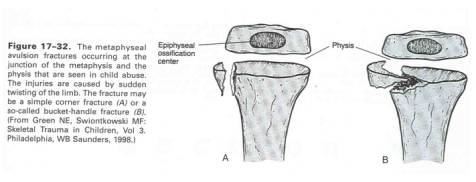As child abuse can be sexual, psychological or physical, the term battered child syndrome was introduced to describe only the physical manifestations of such atrocities. Kemp, in 1962, described this entity as a pattern of repeated episodes of severe physical injury inflicted by a caregiver.
There is, of course, no exact pattern of injuries that can be considered diagnostic for battered child syndrome, though it is widely considered indicative of such when finding a patient with multiple fractures in different stages of healing. Complicating this, however, is the fact that most abused children have only one fracture. Sadly, if the patient is discharged home without intervention of child protective services, rates of re-injury can approximate 30-50%, and carry a 15-20% mortality risk. Approximately 30% of cases of abused children are said to be first seen by an orthopedist.
As always, meticulous documentation is of paramount importance. A thorough history and physical will allow for evidence that may become important in the protection of the child’s best interests. Photographs, radiographs and bone scans can be helpful. Early involvement of child protective services is essential, and a skeletal survey can be helpful in discovering otherwise missed injuries. As well, head CT or MRI can be helpful in documenting intracranial hemorrhage, and a careful ophthalmologic exam can detect retinal hemorrhage.


